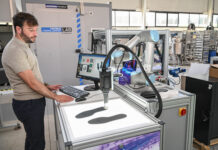Fast-forward to the year 2025: Climate change has proven to be real. eVehicles have completely replaced fossil fuel-driven vehicles. The Extended Producer Responsibility packaging revolution has happened. Plastic packaging made from starch instead of fossil-fuel plastics is in demand.
A Punjab farmer points to a large hectarage of high yielding potato plants and says they will soon be harvested for conversion to starch-based bioplastic packaging. On the other side, the farmer points to another, less bountiful potato crop which he says will be converted to the potato chips packaged in bioplastics based pouches.
Similarly, at another farm in Maharashtra, a sugar cane farmer proudly shows his acreage of sugar cane meant for making packaging alongside a crop of sugar cane for conversion to sugar. Indeed, India’s impoverished farmers have readily shifted to cultivating starch for bioplastics, which offers them higher cash returns. A second Green Revolution has come to the country, but this time instead of food, it is a Green Plastics Revolution. As a result, farming for food crops has taken a hit. From being a food-basket for its population, India has turned into being a basket-case producer of bioplastics.
Wait, wait, wait – CTRL, ALT, DEL – let’s reboot the above. It must be the haze caused by attending so many conferences and hearing about the evils of Post Consumer Use (PCU) packaging litter and its management that is causing me to daydream in this way. Ever since the world started taking climate change and marine litter headlines seriously, discussions about packaging are no longer about how to make it better, brighter, and stronger. Instead, the talk is about how to make it disappear, or better still, not appear at all in the first place. The keywords in all these discussions nowadays are, of course, the usual suspects – Extended Producer Responsibility, sustainability, circular economy, composting, recyclability, source reduction, and finally, bio-degradability in all its variants of oxo-degradability and aqua-degradability and so on.
With such a vast field of mostly unexplored options, it is no surprise then that each aspect of the PCU EPR debate has its devoted proponents and evangelists. The plastics lobby, represented by the All India Plastics Manufacturing Association, is vigorously defending the life-saving role and contribution of plastics for a better life.
The PET bottle manufacturers never lose an opportunity to point out that India has the best informal PET bottle recycling system in the world, thanks to the sheer survival needs of its band of intrepid ‘rag pickers.’ The tinplate and glass manufacturing industries take advantage of the attacks on plastics packaging to make flanking moves by driving home the sustainability and circularity of the glass and tinplate economy.
In the meantime, paper packaging is rapidly re-inventing itself to offer more robust solutions that could help to replace multi-layer flexible packaging and even rigid plastic formats. The traditional multi-layer flexible packaging (MLP) convertors are rising to the challenge too by creating ‘mono-material’ laminates and highlighting MLPs as the most’ resource efficient’ form of packaging with the least carbon footprint.
Greenwashing and eco-anxiety
There is no doubt that the world of packaging at this time is in the midst of a significant churn. It is driven by the incessant greenwashing of packaging EPR issues by salesmanship and marketeering created by the climate change activists with support from media and government. It has driven almost all major consumer brand companies around the world to grandly announce their EPR driven goals and fix CSR targets to satisfy their eco-anxiety and guilt-driven customers.
Unilever has declared its intention to ‘transform our use of plastic packaging by 2025.’ It goes on to say, ‘Decoupling our growth from our environmental impact is at the heart of our Unilever Sustainable Living Plan targets to reduce the weight of our packaging by one third by 2020 and halving the waste associated with the disposal of our products by 2020. 100% of our plastic packaging will be reusable, recyclable or compostable by 2025.’
Unilever is not alone in making such pronouncements. P&G made ‘a global commitment in April 2018 for its packaging to be 100% recyclable or reusable by 2030.’ Beiersdorf aims to embed ‘environment evaluation’ throughout its product development process. It seeks to ‘look critically at all the aspects of a product over its entire life-cycle, from the selection of raw materials and packaging, through production and transport processes, all the way to the product’s final disposal.’ Their objective is to achieve a ‘reduced environmental impact.’
Garnier has also pledged to continue efforts to reduce plastic use by committing to 100%, post-consumer recycled (PCR) waste for shampoo and conditioner bottles. It should be apparent from such commitments to Planet Earth for future generations, that they are real and well-intended.
Sustainability puzzle
In the overall sustainability puzzle, we often hear of the various R’s of packaging, such as Reduce, Reuse, Recycle, Replace, and Renew. Now another R is proving to be the hardest to deal with, and that is the R of ‘real and well-intended.’ To meet intended sustainability goals, companies have to make choices at appropriate decision points based on binaries of yes or no. For example:
- Should we reduce variants of our packaging? Yes/no?
- Will source reduction work for us? Yes/no?
- Should we focus on the recyclability of our packaging? Yes/no?
- Is bioplastics a better choice than recyclability? Yes/no?
- Will bioplastics solve the EPR of PCU litter? Yes/no?
- Will municipalities ensure the collection and composting of bioplastics litter? Yes/no?
- Will fossil fuel-based plastics be unaffordable for packaging in the near future? Yes/no?
It is questions, questions, and questions like these that are presently being dealt with by those charged with the responsibility of making sustainable choices. In the midst of this, it is easy to see that a whole new set of businesses have emerged which deal with packaging waste management in an organized and technology-driven way. For example, Suez is a ‘resources management company’ that offers to ‘transform waste to value.’ (www.suez.com). It has projects all across the world and promotes itself with the tagline – ‘innovating for the future.’
Closer home, Gem Recycling is a producer responsibility organization (a new PRO has already entered the new lexicon) that helps brand owner companies meet EPR stipulations. (www.gemrecycling.com). Similarly, there is Nepra, which specializes in the collection and sorting of packaging waste. (www.nepra.co.in).
To assist such waste management businesses, several machine manufacturers offer sensor-based sorting technology that can efficiently replace the need for manual sorting of waste — for example, Tomra at www.tomra.com.
Biobased biodegradable
However, amidst all these efforts at organized EPR around the world, the bioplastics industry is also making valiant efforts to establish itself as a viable packaging choice. According to one report by the European Bioplastics (www.european-bioplastics.org), a total of 1.70 million tons of bioplastics were produced in year 2014 around the world. Among these, the top four startup companies’ disrupting the packaging industry’ are GF Biochemicals, Willowridge Plastics, Cellucomp, and Eranova.
An important aspect of the entire bioplastics discussion is that not all bioplastics are readily biodegradable in the open environment. Most so-called biodegradable materials require industrial composting to be degradable. In this connection, a look at the accompanying diagram is informative. The good news appears to be that UFlex has made a breakthrough in making ordinary fossil fuel-based plastic (for MLP) also readily and fully biodegradable in the open environment with the addition of specific enzymes to the masterbatch. These enzymes are capable of ‘digesting’ littered plastic in a short time. UFlex has generously offered to share this technology breakthrough for ‘the benefit of society and Planet Earth.’
With all this happening, we once again recycle back to the question of what will save the world – recycling or biodegradability? If extended producer responsibility could be extended a little more to include the consumers also then a well-managed mix of recycling and composting could be sufficient. The jury is out. The lure of bioplastics may well turn out to be like the story of Jack and the Beanstalk, where Jack plants a magic seed of bioplastics, which grows into a huge giant that comes down to consume what’s left of humanity after climate change.












This perspective fails to acknowledge that compostable bioplastics are at times the best choice for applications that result in organic contamination of the packaging. The can cost effectively facilitate the diversion of organic waste from landfill and provide a more cost effective way of “recycling”. It also does not take into account that the future bioplastics will be made from non agricultural feedstocks like bacterial, seaweed, and other biological sources. I disagree that the choice is binary, the choice is to use compostable biobased materials when appropriate. With rapid improvements in recycling technology and potential chemical recycling breakthroughs will allow plastics to be truly circular and recycled back into high grade materials, plastics will continue to play a role however with intrinsic value they will no longer be discarded after a single use.
Thank you for this comment. I agree that “future bioplastics” are yet to emerge and could very well be based on non-agricultural feedstocks and also prove to be truly circular based on chemical recycling techniques. Its also correct to say that “single use” items made from fossil fuel based plastics will no longer be discarded due to their intrinsic value. In either case it appears “cost efficient recycling” is the answer.
Until these multinational companies are pressured to change their packaging, the problem with plastics (compostable, fossil-based or biobased) won’t go away. The retail “sachet” culture prevalent in SouthEast Asia is a big example of a major problem.
True enough. Multinational companies and large, popular brands are already under pressure from the PWM Rules as well as public opinion. A lot of companies have made declarations on their websites and public platforms to change their packaging in order to reduce adverse impact on the environment. However, the “sachet” culture, as you term it, remains a necessity in markets with low purchasing power. Innovative solutions to offer low price-point packs to the bottom-of-the-pyramid market, which can meet environment safety criterion are the need of the day.